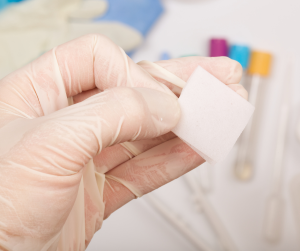Alcohol After Puncture?
A technical question submitted by a reader regarding an unusual patient request.
by Shanise Keith • February 02, 2022
Trigger-warning: Before reading this post, please be aware that there is a paragraph that mentions the topic of self-harm in the discussion. This is a medical-related blog, and therefore sometimes discussions may include sensitive topics such as this, but we will always give a warning beforehand.
Dear Center for Phlebotomy Education,
I am reaching out regarding an interesting request from one of our patients yesterday, as I was hoping for your feedback on the situation. The patient requested that an alcohol pad (instead of gauze) be placed over the venipuncture site after their blood draw was complete; this is how they wanted it bandaged. The phlebotomist kindly explained that this might burn and could potentially cause bruising and tried to persuade the patient to allow her to use the gauze instead, but the patient was adamant that the alcohol pad be used. The phlebotomist obliged but was still concerned, so I wanted to know your thoughts on this. Did the phlebotomist handle this request properly, or

was there more she should have done? Or maybe this is a technique we are not aware of? Your help is greatly appreciated. Thank you in advance!
My response:
Thanks so much for reaching out with this great question. You are correct that using an alcohol wipe instead of gauze will burn, and increases the bleeding time and chance of bruising. It is also not listed as an option for bleeding control in the CLSI standards, and for those reasons, it should not be done.
I have had this requested a few times myself by patients. Once, it was for a woman who had a long history of frequently self-harming. She told me that she always kept alcohol on her cuts, and it would prevent her from getting an infection. She wanted alcohol on her puncture site for the same reason. I explained that the skin had been cleaned with alcohol before the draw, and therefore did not need to be cleaned again, especially since the needle was sterile. Her habit of using alcohol on her fresh injuries was a part of the personal struggles she was dealing with. She continued to insist that she wanted the alcohol on her fresh puncture even after my explanation.
Another patient was extremely germ-phobic and accused me/the company I was working for at the time of not using sterile supplies, even when I opened all the packages in front of him. He wanted the alcohol wipe to sterilize the site after the draw was over, due to not trusting us. I explained the same things to him as I had the first patient, but he did not believe me and kept on insisting.
I did not give either patient an alcohol wipe, but the second patient took one from my cart and used it himself when I refused.
In both of those cases, while there may have been some deeper issues affecting their reasoning, it was also an issue of not trusting in healthcare. I am not saying that is the case in your situation, but it can be really difficult to reason with or convince a patient that the alcohol is not necessary after the draw, and can, in fact, lead to longer bleeding and bruising.
Luckily this is not too common of an occurrence, and not very likely to cause much of a problem besides some bruising. It becomes riskier if the patient is anticoagulated or has a bleeding disorder. Potentially it could cause a large hematoma and the complications that arise with that (pain, longer healing, pressure in the area, possible nerve damage from compression, etc.).
If the patient insists on an alcohol wipe after the draw (even after some gentle education by the phlebotomist), then I would recommend for the phlebotomist to simply state that using an alcohol wipe on a fresh puncture is against facility protocol and politely refuse. It would also be wise to document the request from the patient and the phlebotomist's response to the situation. If the patient comes back with a complaint, you will have covered yourselves by following facility protocol and CLSI standards.
Tell your phlebotomist not to worry about it too much, things like this happen and are a part of the learning process. Now they know for next time.
Hope this helps!
Related Posts and Information
overall rating: my rating: log in to rate
Alcohol wipe blood draw CLSI needlestick YouTube professionalism Shanise Keith
56 Comments
Alcohol after puncture
When I first started taking blood for laboratory investigations in the early 1970s in the NHS in UK there were no phlebotomists only lab staff, nurses and medics taking blood samples. It was common practice back then to clean the venepuncture site with an alcohol swab and then post venepuncture apply the same swab to the puncture site, hold it in place with the index finger of the other hand and fold the arm up compressing the puncture site between forearm and bicep. Pain and bruising were common place. This practice was wrong on so many levels. The introduction of trained phlebotomists into health care settings has drastically reduced the practice but I still come across cases occasionally, usually from medical staff who are not venepuncture competent or phlebotomists who have had little in the way of real life practical venepuncture training. It has to be said that in UK phlebotomy is still an unregulated profession despite the lobbying of the National Association
David Rist, 02/03/2022 09:39:07
Instructor
This was informative, I did not know alcohol could prolong bleeding.
Ann Peel, 02/03/2022 13:30:08
Wow.
The part about opening everything in front of a germophobe patient and still be rebuked brings back memories. Overall, response from the author is useful.
JJ, 02/04/2022 19:02:57
